
|
|
19 July, 2004
Although there are a few water stations left, we finished our mud stations
just before lunch today after starting them at midnight last night. Even
though it was late and we were all tired, it was great to be on deck as the
fog lifted and the sun finally came out, staying up for most of the evening.
At one point, we had a sunset that lasted for some time before the sun
dipped just below the horizon and then re-emerged soon after. It was
strange to go from helping Bryan with his mercury sampling (see the journal
entry from the 16th) using the strict "clean hands, dirty hands" technique,
to the deck where we work with Jackie's sampling and get wet and covered in
mud! Although it's somewhat repetitive work, and it's often cold on deck,
the mud seems to have a certain allure. Many of the crew have come to check
out our samples, and one even joined us today to help out at a complete
station. Check out the photo of Vivien Summers, the ship's medical officer
sieving a grab!
Jackie's work involves benthic organisms (those that live on the bottom),
and she has been studying this same area annually since 1984. It's
important to understand what organisms live on the bottom and the
characteristics of their environment in order to see what role they play in
the cycling of carbon, the element that is so critical for all living
things. If you check the cruise map in the journal from the 13th, you'll
see three areas circled. These are "hot spots" where the water is shallow
and most of the food in the water column goes to the sediments. By studying
the same three areas over a number of years, Jackie gets a time series to
better understand the ecological forces at work in the water column and the
sediments. For example, she looks at the carbon supply to the sediments,
recycling of carbon in the sediments, and the community structure of the
invertebrate macrofauna (large animals without backbones). These three
areas are also important because they are home to important top predators
such as the spectacled eider (a threatened population of diving sea ducks),
walruses and gray whales.
Over twenty years, Jackie has seen a decline in the population of the
dominant invertebrate fauna in these three areas. The changes seem related
to changes in water temperature, current flow and carbon supply. For
example, the population of amphipods (a small, pink shrimp-like animal) has
declined in the Chirikov Basin and the gray whales are moving north in
search of food. This area is critical because all the major water masses of
the Bering Sea come together through the Bering Strait and move into the
Chukchi Sea. When Jackie leaves the Laurier, she'll return to the USCGC
Healy where she will continue work on the Shelf Basin Interactions project
which picks up the study further north. All in all, she will have been out
to sea for three months by the time she leaves the Healy in late August.
In order to do her benthic studies, Jackie uses the van Veen grab and the
Haps core. She gets five grabs and three cores from each station. From
these she takes sub samples to analyze for chlorophyll, HPLC see journal for
the 15th), carbon-13, cesium-137, beryllium-7, TOC (total organic carbon)
and TON (total organic nitrogen). Analysis of these samples yields
information about the phytoplankton and how long it has taken to reach the
sediments, the forms of carbon and how much of it arrives at the sediment
surface from the processes taking place in the overlying water column, and
the source of the organic material in the mud. In addition, she looks at
the grain size of the sediment to get an indication of what organisms might
live there.
With her cores, Jackie will do 12 - 24 hour respiration experiments,
allowing the organisms to remain in their "natural" environment so she can
study total community metabolism. She will sieve these cores at the end and
preserve the specimens.
Ari and Rebecca take 1 or 2 cm. sections vertically of the other cores,
placing the mud into cans and freezing it to bring back to the University of
Tennessee for analysis.
I promised you some photos of the van Veen work including getting the mud
and sieving it (check the journal from July 15), and I've included those
today along with some of Jackie's work. The picture of the sieved mud grab
shows lots of mollusks (clams and a few snails) and worms, but we have also
found a few small sea cucumbers, lots of pink brittle stars, a few crabs,
and an occasional sea anemone. All the sieved samples are preserved and
returned to the University of Tennessee for analysis. I'm not sure who to
thank for some of the pictures since I took them from the file from the
ship.

It's not hard to be out on deck at 3 AM when the view looks like this!
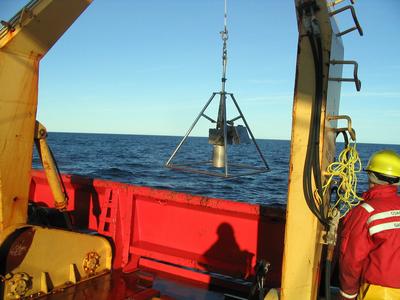
The Haps core collects a core sample of the sediment. --
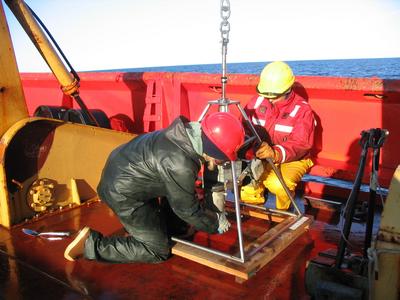
Jackie has to remove the core sample carefully. --
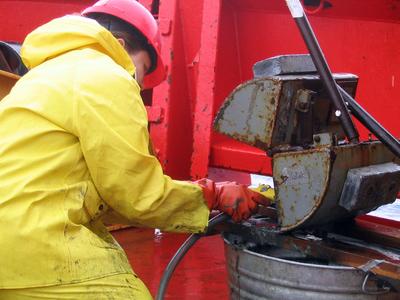
Once the van Veen comes on board, we dump the mud into a bucket and wash the van Veen to be sure we collect ALL the mud. --
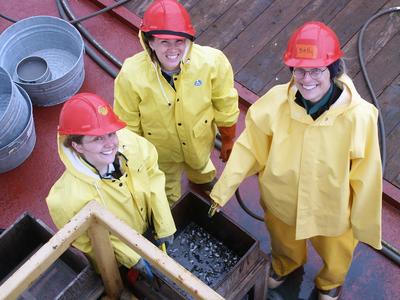
This is clearly a posed picture of, l. to r., Ari Balsom, Rebecca Pirtle-Levy and me standing by the sieve boxes. Since there is no mud in the box, we have finished sieving. --
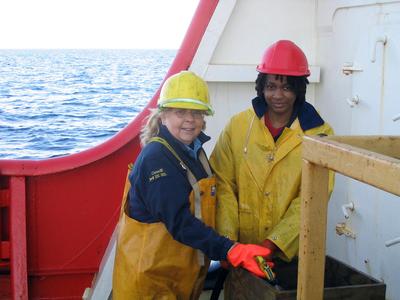
We really enjoyed it when Vivien Summers, the ship's Medical Officer, helped us sieve our van Veen mud samples. She's working here with Alicia Clark. --

This is a fairly typical grab sample with lots of mollusks and worms. At other sites, we found pink brittle stars, snails, sea cucumbers, crabs, and even a few sea anemones. --
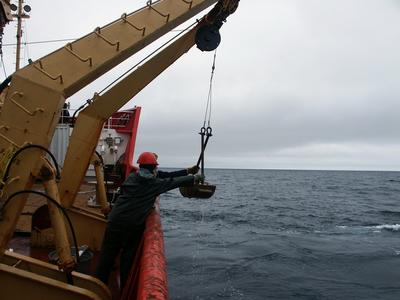
This van Veen is coming back on board; you can tell because it is closed around the mud sample. --
Contact the TEA in the field at
.
If you cannot connect through your browser, copy the
TEA's e-mail address in the "To:" line of
your favorite e-mail package.
|
